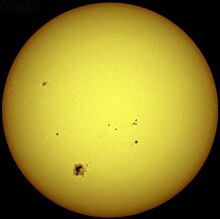Solar physics
As solar physics , the branch of is astronomy and solar research indicated that the sun with their physical has forms the subject.
Its modern development essentially began with the invention of spectral analysis in 1858.
Important phenomena and methods
In its development, solar physics shows a clear connection with measurement technology and the increase in possibilities to observe physical phenomena of the solar surface and solar radiation.
In approximately historical order, the following subject areas are to be cited:
- Solar radiation and heat balancing
- Mass of the sun and mechanics of the solar system
- Sunspots and sun rotation
- Photosphere and solar constant
- Spectral analysis (see Fraunhofer lines )
- H-alpha radiation (see also Balmer series and H-alpha telescope ) and structure of the chromosphere
- Convection and hyper granulation
- Magnetic fields and solar activity
- Interaction of the solar wind with the earth's magnetic field and ionosphere
- Nuclear fusion in the sun's core and heat transfer to the surface
- what is the dawn of the general - thermodynamic equilibrium models of the sun stratification stellar physics isengaged represented
- Radio radiation from the sun and its causes
- Measurement and modeling of infrared and UV radiation
- Neutrino research
- X-rays and gamma rays
- Cosmogony of the sun and the planetary system
Kick-off for the development of astro and stellar physics

Solar physics is one of the largest areas of astrophysics and has given significant impulses to its development and that of atomic physics . At the beginning of modern solar physics are the research of Joseph von Fraunhofer on the solar spectrum and the resulting methods of spectral analysis .
A major development step in the 20th century was the expansion of the visual spectrum to include radiation of shorter and longer wavelengths, as well as interactions with modern particle physics .
Some eminent solar researchers
Antiquity until around 1800
- Aristotle , Pythagoras , Ptolemy , al-Ma'mun
- Athanasius Kircher , Galileo Galilei , Christoph Scheiner , Roger Joseph Boscovich
19th century
20th century
- Arthur Eddington , Hans Elsässer , Karl-Otto Kiepenheuer , Gerard Peter Kuiper , Karl Stumpff , Albrecht Unsöld , Harold Clayton Urey , Hans-Heinrich Voigt , Max Waldmeier et al.
literature
- Max Waldmeier : Results and Problems of Solar Research. 2nd expanded edition. Geest & Portig, Leipzig 1955.
- Karl Stumpff (Ed.): Astronomy. Fischer, Frankfurt am Main 1957, chapter solar physics .
- Wolfgang Mattig: The sun. Beck, Munich 1995, ISBN 3-406-39001-3 ( Beck's series 2001 knowledge ).
- Helmut Zimmermann and Alfred Weigert : Lexicon of Astronomy. 8th edition. Spectrum, Heidelberg a. a. 1999, ISBN 3-8274-0575-0 .
- J. Herrmann : dtv atlas astronomy. With star atlas. 14th revised edition. Deutscher Taschenbuch-Verlag, Munich 2000, ISBN 3-423-03006-2 ( dtv. Dtv-atlas 3006).
- Wolfgang Mattig: Before solar observation became solar physics - in Germany and the surrounding area. (PDF file; 60 kB) In: SONNE. Bulletin of the amateur sun watchers. No. 103 = Vol. 26, 2002, ISSN 0721-0094 , pp. 67-71.
- Michael P. Seiler: "Sun god" is a matter of command. History of German solar research in the Third Reich and under Allied occupation. German, Frankfurt am Main 2007, ISBN 978-3-8171-1797-0 ( Acta Historica Astronomiae 31).
Web links
- Living Reviews in Solar Physics
- Solar Physics of NASA's Marshall Space Flight Center
- George W. Collins, II: The Fundamentals of Stellar Astrophysics (online book)
